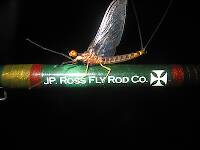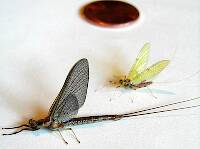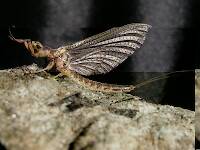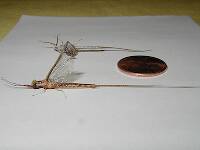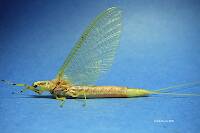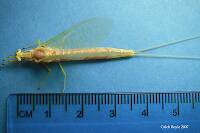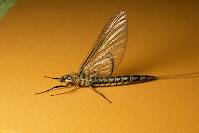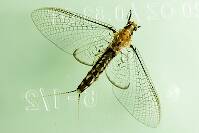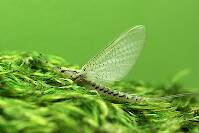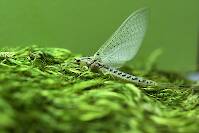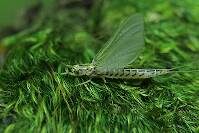
Blue-winged Olives
Baetis
Tiny Baetis mayflies are perhaps the most commonly encountered and imitated by anglers on all American trout streams due to their great abundance, widespread distribution, and trout-friendly emergence habits.
Featured on the forum
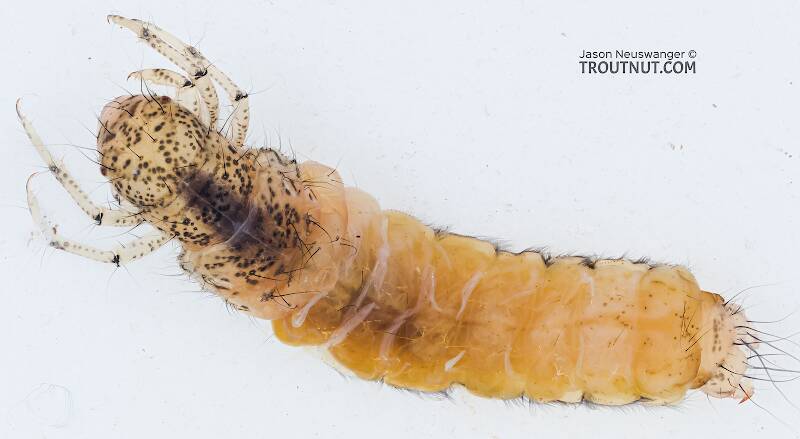
This is a striking caddis larva with an interesting color pattern on the head. Here are some characteristics I was able to see under the microscope, but could not easily expose for a picture:
- The prosternal horn is present.
- The mandible is clearly toothed, not formed into a uniform scraper blade.
- The seems to be only 2 major setae on the ventral edge of the hind femur.
- Chloride epithelia seem to be absent from the dorsal side of any abdominal segments.
Based on these characteristics and the ones more easily visible from the pictures, this seems to be Grammotaulius. The key's description of the case is spot-on: "Case cylindrical, made of longitudinally arranged sedge or similar leaves," as is the description of the markings on the head, "Dorsum of head light brownish yellow with numerous discrete, small, dark spots." The spot pattern on the head is a very good match to figure 19.312 of Merritt R.W., Cummins, K.W., and Berg, M.B. (2019). The species ID is based on Grammotaulius betteni being the only species of this genus known in Washington state.
- The prosternal horn is present.
- The mandible is clearly toothed, not formed into a uniform scraper blade.
- The seems to be only 2 major setae on the ventral edge of the hind femur.
- Chloride epithelia seem to be absent from the dorsal side of any abdominal segments.
Based on these characteristics and the ones more easily visible from the pictures, this seems to be Grammotaulius. The key's description of the case is spot-on: "Case cylindrical, made of longitudinally arranged sedge or similar leaves," as is the description of the markings on the head, "Dorsum of head light brownish yellow with numerous discrete, small, dark spots." The spot pattern on the head is a very good match to figure 19.312 of Merritt R.W., Cummins, K.W., and Berg, M.B. (2019). The species ID is based on Grammotaulius betteni being the only species of this genus known in Washington state.

Troutnut is a project started in 2003 by salmonid ecologist Jason "Troutnut" Neuswanger to help anglers and
fly tyers unabashedly embrace the entomological side of the sport. Learn more about Troutnut or
support the project for an enhanced experience here.
WovenPerla has attached these 3 pictures to aid in identification. The message is below.
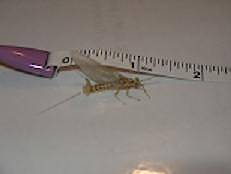
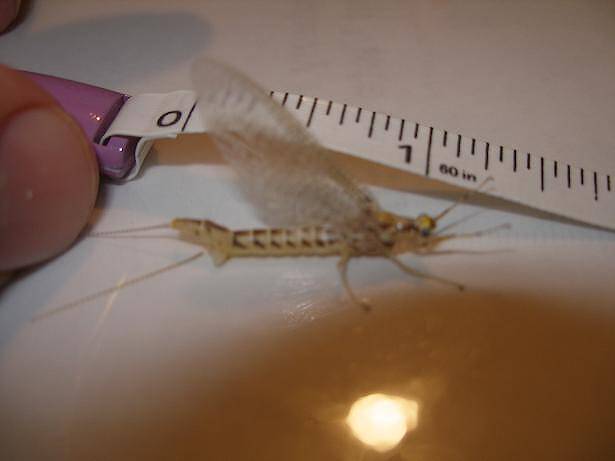
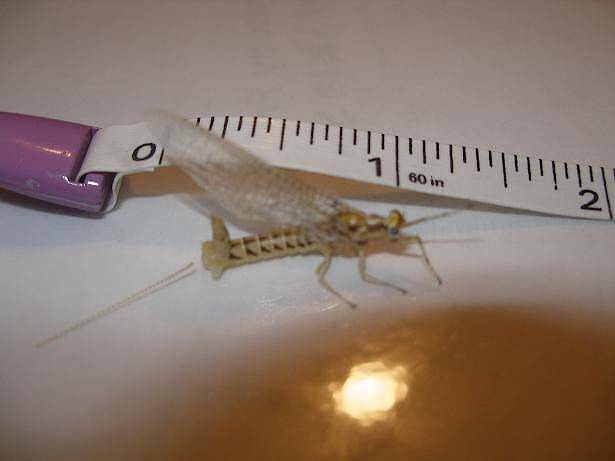
WovenPerla on Jun 18, 2009June 18th, 2009, 4:01 pm EDT
I saw two of these bugs at a local ice cream shop near the Susquehanna River just north of Harrisburg where bugs like to hang out after dark. I collected the specimen on June 18th, too late for any type of drake, so I figured it must be a Hex. I know the river and some local streams have has H. atrocaudata later on in July and in August (depending on the watershed), but I didn't know that / if there were H. limbata. Am I correct on my identification (well...assumption...I really didn't identify it in any scientific manner...just by association and elimination.) Thanks for the commentary.
Taxon on Jun 18, 2009June 18th, 2009, 4:50 pm EDT
Christopher-
Your mayfly appears (to me) to be a Hexagenia limbata female imago.
Your mayfly appears (to me) to be a Hexagenia limbata female imago.
WovenPerla on Jun 19, 2009June 19th, 2009, 3:04 am EDT
Thanks. That's what I thought. I just was surprised because it seems everyone makes a big deal about them everywhere else, but no one talks about them here really.
I'm assuming it hatched from the river or maybe the local trout stream nearby...do you think this would be a good fly to try and imitate with bass? Swinging wetflies? Would wet flies work after dark on the trout stream?
I'm assuming it hatched from the river or maybe the local trout stream nearby...do you think this would be a good fly to try and imitate with bass? Swinging wetflies? Would wet flies work after dark on the trout stream?
GONZO on Jun 19, 2009June 19th, 2009, 3:48 am EDT
Hi Chris,
Because we recently discussed this subject, Roger is probably expecting a post from me, and I wouldn't want to disappoint him by not taking the bait. Although I agree with Roger that this does look like a Hexagenia limbata spinner, I think it could also be H. rigida.
I lived in the Harrisburg area for about half of my life, and a surprising number of burrowing mayflies are found right in that immediate area. There are four Hexagenia species (limbata, rigida, atrocaudata, and bilineata) as well as Green and Yellow Drakes (Ephemera guttulata and varia). Although I haven't been able to confirm it personally, another big burrower, Litobrancha recurvata, is said to be found in at least one stream flowing into the Susquehanna in the vicinity of H-burg. (Though recurvata probably would not be found in the river.)
Of the Hexagenia species, atrocaudata and bilineata can be easily ruled out. That leaves limbata and rigida. The problem is that rigida is so similar in appearance to one or two of the limbata varieties ("morphs") that they can only be conclusively identified by the distinctive genitalia of the males or the chorionic egg structures of the females. In other words, it is probably impossible to ID your specimen with any certainty based on the photo.
It is my impression (and only an impression) that rigida might be the more common Hex species found in that area. Further suggestive (though not at all conclusive) evidence comes from a very nice study of Hexagenia that was done by Dr. Spieth back in the forties. In that study, he lists records of three of the four Hex (limbata, rigida, and bilineata) collected right at Harrisburg, and the fourth (atrocaudata) at Chambersburg. The interesting thing is that the Harrisburg limbata record is of the morph that was described in his study as as a subspecies of what was then considered to be a separate species, Hexagenia munda affiliata. This is now considered to be a synonym of limbata. Spieth's description of the habitat of the affiliata morph ("As yet I know it to be taken only from clear, clean, usually small streams and small lakes") would lead me to wonder if the population in the Susquehanna might be rather sparse. The dorsal markings of that morph are described as being rather different than your specimen--darker and of a different configuration--and the markings on your specimen appear to be fairly consistent with rigida. However, the catch is that such distinctions are much harder to make with female specimens of these species. So, all I can really say is that both limbata and rigida are probably found in the river, both emerge at about the same time, and your specimen could be either one. (From a fly-fishing/imitation standpoint the distinction between these species makes virtually no difference.)
Although Roger could be right about this being limbata, as Dr. Spieth says in his study, "This species has always been the dispair of ephemeropterists."
PS--I just noticed your latest post, Chris, and my answers would be yes, yes, and yes. I would normally imitate Hex with nymphs and dries on trout streams, but it is hard to argue against swinging a big wet after dark, even when Hex are not hatching.
Because we recently discussed this subject, Roger is probably expecting a post from me, and I wouldn't want to disappoint him by not taking the bait. Although I agree with Roger that this does look like a Hexagenia limbata spinner, I think it could also be H. rigida.
I lived in the Harrisburg area for about half of my life, and a surprising number of burrowing mayflies are found right in that immediate area. There are four Hexagenia species (limbata, rigida, atrocaudata, and bilineata) as well as Green and Yellow Drakes (Ephemera guttulata and varia). Although I haven't been able to confirm it personally, another big burrower, Litobrancha recurvata, is said to be found in at least one stream flowing into the Susquehanna in the vicinity of H-burg. (Though recurvata probably would not be found in the river.)
Of the Hexagenia species, atrocaudata and bilineata can be easily ruled out. That leaves limbata and rigida. The problem is that rigida is so similar in appearance to one or two of the limbata varieties ("morphs") that they can only be conclusively identified by the distinctive genitalia of the males or the chorionic egg structures of the females. In other words, it is probably impossible to ID your specimen with any certainty based on the photo.
It is my impression (and only an impression) that rigida might be the more common Hex species found in that area. Further suggestive (though not at all conclusive) evidence comes from a very nice study of Hexagenia that was done by Dr. Spieth back in the forties. In that study, he lists records of three of the four Hex (limbata, rigida, and bilineata) collected right at Harrisburg, and the fourth (atrocaudata) at Chambersburg. The interesting thing is that the Harrisburg limbata record is of the morph that was described in his study as as a subspecies of what was then considered to be a separate species, Hexagenia munda affiliata. This is now considered to be a synonym of limbata. Spieth's description of the habitat of the affiliata morph ("As yet I know it to be taken only from clear, clean, usually small streams and small lakes") would lead me to wonder if the population in the Susquehanna might be rather sparse. The dorsal markings of that morph are described as being rather different than your specimen--darker and of a different configuration--and the markings on your specimen appear to be fairly consistent with rigida. However, the catch is that such distinctions are much harder to make with female specimens of these species. So, all I can really say is that both limbata and rigida are probably found in the river, both emerge at about the same time, and your specimen could be either one. (From a fly-fishing/imitation standpoint the distinction between these species makes virtually no difference.)
Although Roger could be right about this being limbata, as Dr. Spieth says in his study, "This species has always been the dispair of ephemeropterists."
PS--I just noticed your latest post, Chris, and my answers would be yes, yes, and yes. I would normally imitate Hex with nymphs and dries on trout streams, but it is hard to argue against swinging a big wet after dark, even when Hex are not hatching.
Taxon on Jun 19, 2009June 19th, 2009, 9:20 am EDT
In the hope of diverting some attention from another thread, and also in the interest of relieving some pressure from Gonzo, who fears he may have exceeded nearly everyone's threshold for detail in his above posting, I offer this illustration of some of Hexagenia male imago genitalia taken from the book, The Biology Of Mayflies, by Needham, Traver, and Hsu. Close examination of this illustration, and only by those whose sensibilities it does not offend, may yield appreciation for the role anatomy played in naming of certain species.


GONZO on Jun 19, 2009June 19th, 2009, 9:40 am EDT
Nice, Roger. Thanks on both fronts. :)
GONZO on Jun 21, 2009June 21st, 2009, 7:05 am EDT
Tasty dish, John. (And you're probably safe on the ID; the only WI records of rigida that I have seen came from Dane County.) :)
Shawnny3 on Jun 28, 2009June 28th, 2009, 2:49 am EDT
Is it the shape of the male genitalia that gives recurvata its name?
-Shawn
-Shawn
Jewelry-Quality Artistic Salmon Flies, by Shawn Davis
www.davisflydesigns.com
www.davisflydesigns.com
GONZO on Jun 28, 2009June 28th, 2009, 4:06 am EDT
Shawn,
I believe so, and rigida is similarly descriptive. Another example of such names is the unfortunate one given to one of the Pycnopsyche caddisfly species: scabripennis.
I believe so, and rigida is similarly descriptive. Another example of such names is the unfortunate one given to one of the Pycnopsyche caddisfly species: scabripennis.
Jmd123 on Jun 30, 2009June 30th, 2009, 12:42 pm EDT
Mmmmmmmmmmmmmmmmm, yummy!!
- 27" fat brownie
- 27" fat brownie
No matter how big the one you just caught is, there's always a bigger one out there somewhere...
Quick Reply
Related Discussions
Topic
Replies
Last Reply







